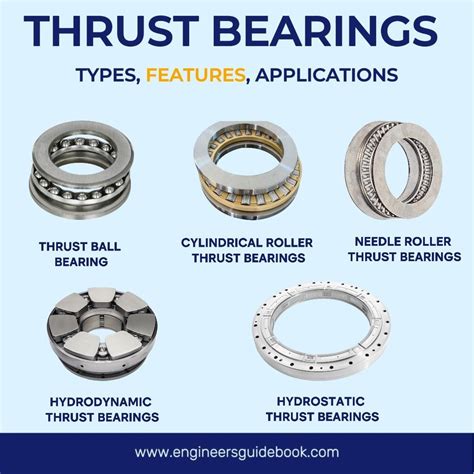Thrust Bearings: Essential Components for Rotating Machinery
Thrust bearings are critical components in various mechanical applications where axial forces need to be managed. Their primary function is to support and guide rotating shafts, ensuring smooth operation and preventing excessive wear. This comprehensive guide delves into the intricacies of thrust bearings, exploring their types, applications, advantages, and essential considerations for optimal performance.
Understanding Thrust Bearings
Thrust bearings differ from radial bearings, which primarily support radial loads perpendicular to the shaft axis. Thrust bearings, on the other hand, are designed to withstand axial forces parallel to the shaft axis. They typically consist of two opposing bearing surfaces, one fixed and the other rotating with the shaft.
Types of Thrust Bearings
The selection of an appropriate thrust bearing depends on several factors, including load capacity, speed, operating conditions, and space constraints. The most common types of thrust bearings include:
-
Ball Thrust Bearings: These bearings utilize hardened steel balls as rolling elements, providing high load capacity and moderate speed capabilities. They are commonly found in automotive transmissions, gearboxes, and other applications with limited axial space.

-
Roller Thrust Bearings: Roller thrust bearings employ cylindrical or tapered rollers as rolling elements, offering higher load capacities than ball thrust bearings. They are often used in heavy machinery, such as rolling mills, turbines, and marine propulsion systems.
-
Tapered Roller Thrust Bearings: These bearings combine the features of roller thrust bearings and tapered roller bearings. They provide high axial load capacity and accommodate moderate misalignment. They are ideal for use in industries such as mining, construction, and wind turbines.


-
Hydrodynamic Thrust Bearings: These bearings utilize a thin film of pressurized fluid to separate the bearing surfaces, eliminating friction and providing virtually unlimited load capacity. They are commonly found in large-scale machinery, such as steam turbines, compressors, and generators.
Applications of Thrust Bearings
Thrust bearings find widespread use in a variety of industries, including:
- Automotive Transmissions
- Gearboxes
- Rolling Mills
- Turbines
- Marine Propulsion Systems
- Printing Presses
- Wind Turbines
- Aerospace Applications
- Steel Production
- Mining Equipment
- Construction Machinery
Advantages of Thrust Bearings
Thrust bearings offer several advantages over other bearing types:
-
High Axial Load Capacity: Thrust bearings are specifically designed to handle substantial axial forces, making them suitable for applications where significant thrust loads are encountered.
-
Low Friction: The rolling or sliding motion of the bearing elements minimizes friction, resulting in improved efficiency and reduced wear.
-
Compact Design: Thrust bearings can be designed in compact sizes, offering space-saving solutions in applications where space is at a premium.
-
High-Speed Operation: Some types of thrust bearings, such as ball thrust bearings, can accommodate high rotational speeds, making them suitable for applications with demanding speed requirements.
Considerations for Optimal Performance
To ensure optimal performance and longevity of thrust bearings, several factors need to be considered:
-
Proper Selection: Selecting the right type and size of thrust bearing is crucial. Factors such as load capacity, speed, operating conditions, and space constraints must be carefully evaluated.
-
Installation: Proper installation is essential to prevent bearing damage and ensure smooth operation. Alignment precision, lubrication, and adequate clearance are critical aspects of installation.

-
Lubrication: Thrust bearings require proper lubrication to minimize wear and friction. The type and frequency of lubrication depend on the bearing design, operating conditions, and manufacturer's recommendations.
-
Monitoring: Regular monitoring of thrust bearing performance, including vibration analysis and temperature monitoring, can help identify potential problems and ensure proactive maintenance.
Common Mistakes to Avoid
Some common mistakes that can compromise thrust bearing performance include:
-
Overloading: Exceeding the rated load capacity of a thrust bearing can lead to premature failure.
-
Improper Installation: Incorrect alignment, inadequate clearance, or insufficient lubrication can cause bearing damage and poor performance.
-
Insufficient Lubrication: Running thrust bearings with insufficient lubrication can result in excessive friction, wear, and overheating.
-
Incorrect Speed: Operating thrust bearings at speeds beyond their rated capabilities can lead to overheating and premature failure.
-
Contamination: Keeping thrust bearings clean and free from contaminants is crucial to prevent damage and performance issues.
FAQs on Thrust Bearings
1. What is the difference between a thrust bearing and a radial bearing?
Thrust bearings support axial loads parallel to the shaft axis, while radial bearings support radial loads perpendicular to the shaft axis.
2. Which type of thrust bearing is most commonly used?
Ball thrust bearings are the most common type, offering a balance of load capacity, speed capability, and compact size.
3. What is the importance of lubrication for thrust bearings?
Lubrication reduces friction and wear, extending bearing life and ensuring smooth operation.
4. How often should thrust bearings be inspected?
The frequency of inspection depends on the application and operating conditions. Regular monitoring can help identify potential problems early on.
5. What are the signs of a failing thrust bearing?
Excessive vibration, noise, or overheating can indicate a failing thrust bearing.
6. How do I choose the right thrust bearing for my application?
Consider factors such as load capacity, speed, operating conditions, and space constraints when selecting a thrust bearing. Consult with an expert if necessary.
Call to Action
Thrust bearings play a vital role in the smooth and efficient operation of rotating machinery across various industries. By understanding their types, advantages, and considerations for optimal performance, you can maximize the lifespan and reliability of your equipment. If you have any specific requirements or questions about thrust bearings, don't hesitate to consult with an expert in the field.

